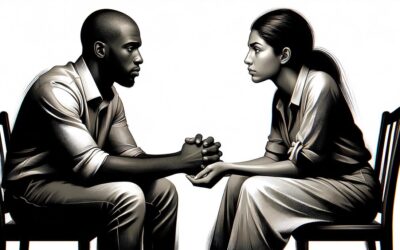Love, a complex and multifaceted emotion, is at the heart of human experience. It binds us together, shapes our lives, and inspires countless stories and artworks. But what lies beneath this powerful emotion? This article seeks to explore the biological, psychological, and social dimensions of love, offering insights into how our brains, bodies, and societies work together to create the feeling we know as love. By examining these different aspects, we aim to provide a comprehensive understanding of love’s role in our lives.
The Biology of Love
The Mystery of Love: Understanding Our Brain and Body Connection
Love, one of the most profound emotions known to human beings, has puzzled scientists and romantics alike for centuries. Have you ever wondered how love works? How do our brains and bodies join forces to create this intense feeling that can both uplift and devastate us? Let’s explore this captivating journey where chemistry meets emotion, shedding light on the intricate dance between our brain and body that orchestrates the experience of love.
The Brain in Love
The brain is the command center of love, playing a pivotal role in generating and regulating our feelings of affection, attachment, and passion. When we fall in love, a cocktail of chemicals and hormones is released, setting the stage for a series of emotional and physiological responses.
Dopamine, often referred to as the “feel-good” neurotransmitter, floods the brain, sparking feelings of euphoria, pleasure, and an intense craving for the object of our affection. This is why being in love can feel exhilarating, akin to the high experienced during certain activities that bring joy and excitement.
Norepinephrine, another critical player, heightens our alertness and focuses our attention on our love interest, making it hard to think about anything or anyone else. This chemical also triggers a racing heart and sweaty palms – the classic symptoms of love at first sight or nervous excitement in the presence of the beloved.
Serotonin levels, interestingly, dip during the initial stages of love, which might explain the obsessive thoughts that often accompany new relationships. It’s as if our brain is conspiring to keep our thoughts fixed on our partner, reinforcing our emotional investment.
Lastly, oxytocin, dubbed the “cuddle hormone”, strengthens the bond between lovers, promoting feelings of connection, trust, and intimacy. Released during hugs, kisses, or even simple physical proximity, oxytocin deepens our attachment to our partner, ensuring the longevity of the relationship.
The Body’s Response
While the brain conducts the orchestra, our bodies play along harmoniously, translating these chemical signals into the physical sensations that accompany love. From the butterflies in your stomach to the warmth of a comforting embrace, our bodies respond in various ways to the presence and thoughts of our loved ones.
The heart, for one, seems to literally beat for our beloved. Studies show that being near or even thinking about our romantic partner can influence our heart rate, causing it to synchronize with theirs in some cases. This physiological empathy underscores the deep connection love fosters, binding us together in a rhythm all our own.
Furthermore, the stress hormone cortisol typically decreases in the presence of a loving partner, reflecting the calming, secure feeling love can bring. This decrease in stress enhances our overall wellbeing, showing how love can serve as a buffer against the pressures of life.
In essence, the love experience is a finely tuned dance between our brain and body, orchestrated by a complex interplay of chemicals and hormones. This dance is not just about the fleeting moments of joy and passion but also about the enduring bonds that connect us deeply with another human being. Love, in all its complexity, showcases the incredible ability of our brain and body to mediate this rich, multifaceted emotion, underlining the profound impact love has on our lives.

Psychological Theories of Love
Building on the essential understanding of love’s physiological and emotional dimensions, we pivot toward examining the theories that elucidate the psychological underpinnings of love. This narrative not only enriches our grasp of how love shapes and is shaped by the human experience but also deepens our appreciation for the myriad ways in which love manifests and influences our lives.
Attachment Theory
At the heart of understanding love through a psychological lens is the attachment theory, initially developed by John Bowlby. This theory suggests that early relationships, particularly between infants and their primary caregivers, lay the foundation for love as it’s experienced in later life. The nature of these early interactions influences an individual’s expectations of love, which surfaces in adult relationships. The theory delineates three primary attachment styles: secure, anxious, and avoidant. Securely attached individuals typically enjoy close, intimate relationships built on trust. In contrast, those with anxious or avoidant attachment styles might find love fraught with challenges, often revolving around fear of abandonment or intimacy.
Triangular Theory of Love
Psychologist Robert Sternberg proposed the triangular theory of love, which posits that love comprises three fundamental components: intimacy, passion, and commitment. Intimacy encompasses feelings of closeness and emotional connection, passion implies physical attraction and romantic feelings, and commitment involves the decision to stay with another and work toward a shared future. According to Sternberg, various types of love emerge from these components, ranging from infatuation, characterized by sheer passion, to consummate love, which balances all three elements. This theory underscores the diversity of love experiences and suggests why love can feel so different across relationships.
Love as a Story
Extending the exploration of love’s psychological terrain, Sternberg also introduced the concept of love as a story. This theory suggests individuals hold certain narratives about love, shaped by personal experiences, cultural influences, and even media consumption. These stories can range from fairy-tale romances to war buddies, each carrying distinct expectations and dynamics. How well partners’ love stories harmonize often dictates the relationship’s satisfaction and longevity. Recognizing and understanding one’s love story can foster deeper connections and facilitate relationship navigation.
Bio-psychological Theory
The bio-psychological theory presents an intriguing blend of biology and psychology, examining love as a product of evolutionary processes. From this perspective, love functions to facilitate mate selection, bonding, and parental support, thereby ensuring the survival and continuation of genetic material. This theory highlights the adaptive aspects of love, emphasizing its role in human development and societal cohesion.
Self-Expansion Theory
Arthur Aron’s self-expansion theory offers a compelling view of love as a means of self-enlargement. According to this theory, romantic love propels individuals to incorporate their partners’ qualities, perspectives, and interests into their own identities, thereby enriching their lives and promoting growth. This desire for self-expansion explains why people often feel energized and transformed by love, experiencing a broader sense of self in the context of a nurturing relationship.
In weaving together these theories, a multidimensional tapestry of love emerges, intricate and beautifully complex. Love, as dissected through the psychological lens, transcends mere emotional or physiological phenomena. It is an intricately woven narrative of human connection, growth, and the quest for meaning and belonging. While our understandings evolve, the essence of love remains a profound, unifying force in the human journey.

The Social and Cultural Dimensions of Love
Turning our gaze to the societal norms and cultural backgrounds, it becomes apparent how these broader forces mold our perceptions and expressions of love in multifaceted ways. Each culture carries its own set of norms, which in turn, influences how love is experienced, shown, and understood by its individuals. This exploration seeks to unravel the threads that weave the complex fabric of love across different societal landscapes.
In many Western societies, love often emphasizes individual choice and romanticism. The notion of finding a ‘soulmate’ underscores the quest for a deeply personal and unique connection between two people. These societies tend to celebrate the idea of romantic love as a cornerstone of relationship building, with a strong focus on emotional fulfillment and personal happiness.
Conversely, in more collectivist cultures found in many parts of Asia, Africa, and the Middle East, love and marriage are frequently viewed through the lens of family and community ties. Here, love might evolve post-marriage, with greater emphasis on duty, partnership, and mutual respect. The notion of familial harmony and approval plays a significant role in the formation and maintenance of these relationships.
Furthermore, the expression of love can dramatically differ based on cultural norms. In some cultures, public displays of affection (PDAs) are common and widely accepted, showcasing love openly through hugs, kisses, and holding hands. Meanwhile, in more conservative societies, such expressions are reserved for private moments, and love is shown through acts of service, commitment, and verbal expressions within the privacy of the home.
Religious beliefs also deeply influence perceptions of love, dictating not only the acceptable forms of expressing love but also shaping the very foundation upon which relationships are built. Whether it’s the significance of marriage within certain religions or the moral codes about love and relationships, these beliefs are ingrained from a young age, guiding individuals in their love lives.
Digital technology has introduced another layer to how societal norms and cultural backgrounds impact love. Online dating, for instance, has opened up new avenues for finding love, transcending geographical and, often, cultural barriers. However, it also presents challenges in maintaining cultural traditions and norms in the face of globalized ways of forming relationships.
The journey of love is also significantly shaped by the narratives and stories that cultures hold dear. From the tragic romance of Romeo and Juliet in Western literature to the profound stories of loyalty and duty found in Eastern texts, these narratives offer models of love that resonate with individuals, influencing expectations and ideals around love and companionship.
In closing, the impact of societal norms and cultural backgrounds on love is both profound and nuanced. While the universal quest for love connects us all, the ways in which we interpret, express, and nurture love are wonderfully diverse. As we navigate the complexities of love across different cultural landscapes, it’s essential to appreciate both the uniqueness and the commonalities of love’s nature. Understanding these differences enriches our own perceptions of love, allowing for deeper, more empathetic connections in our globalized world.

Throughout this exploration of love from biological, psychological, and social perspectives, we’ve seen how deeply interwoven love is with our very being—shaping our thoughts, actions, and relationships. Love, in its many forms, is a fundamental human experience, driving our deepest connections and providing a rich tapestry for our lives. As we continue to study and understand the various dimensions of love, we unlock greater insights into what it means to be human. This understanding not only enhances our personal relationships but also enriches our collective experience, highlighting the beautiful complexity and universality of love.







